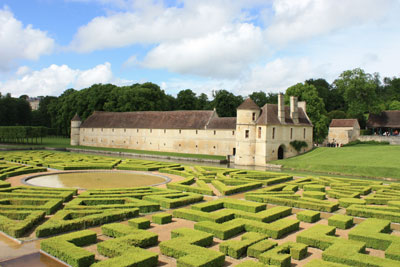
Sentiers du Patrimoine ®
Chaussy
Domaine de Villarceaux, ancien couvent

Longer le domaine en continuant sur le chemin des Porcherons. 500 mètres plus loin prendre à droite. Continuer tout droit jusqu’à l’entrée de la Bergerie de Villarceaux.
Bergerie
Prochain point : lat="49.104716" lon="1.706473"

This vast estate, with a total surface area of around 800 hectares, comprises three chateaus, annexes, a former sheep farm, a 63 hectare park and a renaissance garden, whose water features and lakes are fed by numerous water sources (32 have been counted).
The first known mention of Villarceaux can be found in an 18th century royal decree by King Pepin the Short, granting a “piece of woodland” from Villarceaux to the Saint-Denis Abbey. The first construction on the site of the “chateau du bas” was apparently a small wooden chateau, built around the 11th or 12th century. In the 15th century, it was replaced by a fortified chateau, since the estate served to defend the kingdom's borders during the Hundred Years' War. In the 16th century, the chateau was extended and the estate became a vast agricultural property and also a leisure residence: the vegetable garden was transformed into an ornamental garden, the moat became a swimming pool and the water sources were used to create water features.
The chateau and the park were classed as historical monuments in 1941. The Charles Léopold Mayer Foundation for Human Progress (Fondation Charles Léopold Mayer pour le Progrès de l’Homme), which now owns the estate, entrusted its management to the Paris Region Council in 1989 though a long-term lease.
The most ancient vestige is the base of the tour Saint-Nicolas, which formed the south-west angle of the old castle, known as the château du bas. In the north-west are the annexes, including three principle buildings, each marked with the year 1560 or 1563. In the south-west corner stands a pavilion called the Manoir de Ninon. Ninon de Lenclos, the mistress of Louis de Mornay, lived in this building after some time after 1653. Nicolas de Mornay designed a garden in a small neighbouring valley, named after François 1st, sketching the plans as early as the 16th century.
The château du haut, a Louis 15th style manor, was built in the 18th century by architect Jean-Baptiste Courtonne for Charles-Jean-Baptiste du Tillet de La Bussière, marquis of Villarceaux. The Marquis ordered the old feudal chateau be demolished and built the château du haut along with its park overlooking the small valley, creating a dramatic vista. Originally woodland, the site was transformed into French formal gardens, with an upper section organised around the chateau and below a vertugadin-style terraced garden following the natural slope of the land. The orangery, built in the 19th century, served as winter protection for the orange trees that were once placed decoratively around the exterior of the chateau. Two pavilions line the entry: a chapel and a guard's lodge.
The benedictine priory of Sainte-Marie-Madeleine is thought to have been founded around 1150 by King Louis VII, under the authority of the Saint-Cyr Abbey. During the revolution, the convent became a national asset. It was purchased in 1789 by Joseph Lakanal who demolished the now disused priory buildings, conserving only the main lodgings. The château du couventwas subsequently constructed, taking on its current appearance in 1870. It now hosts the club-house of the Villarceaux golf course.


